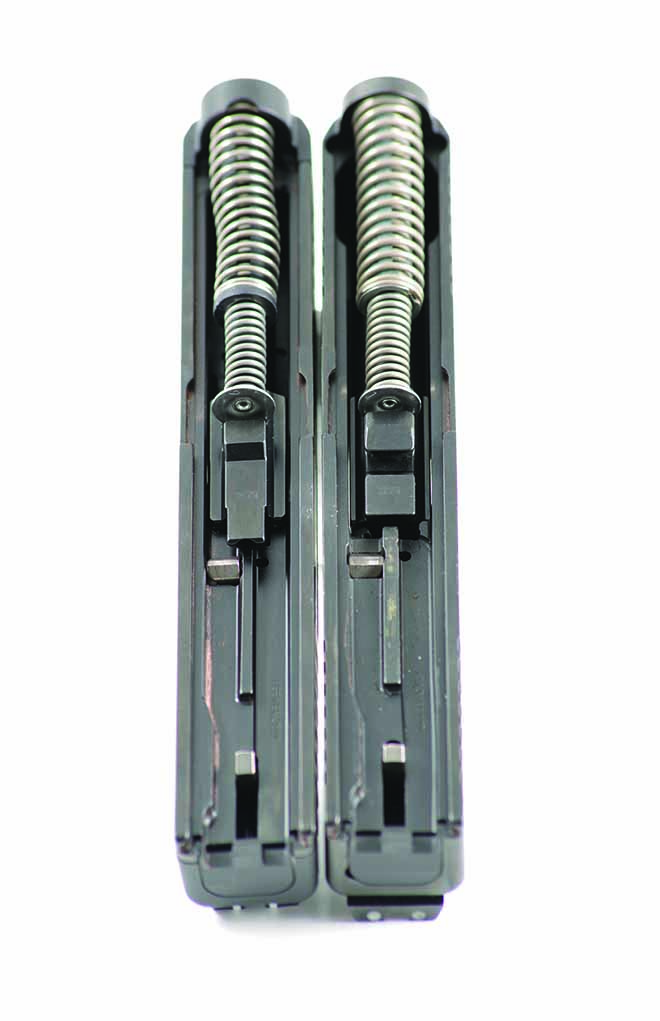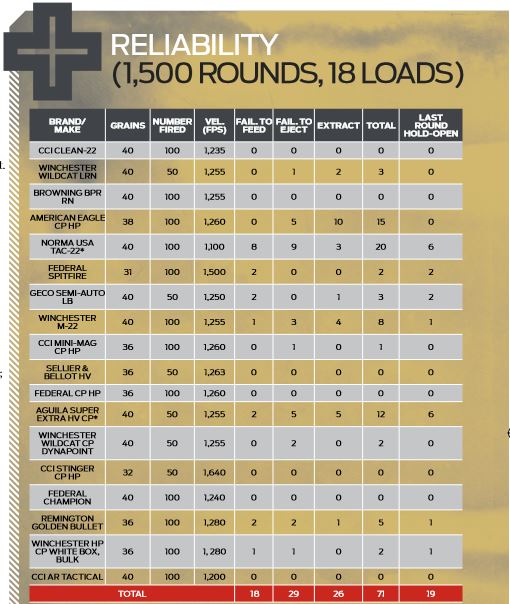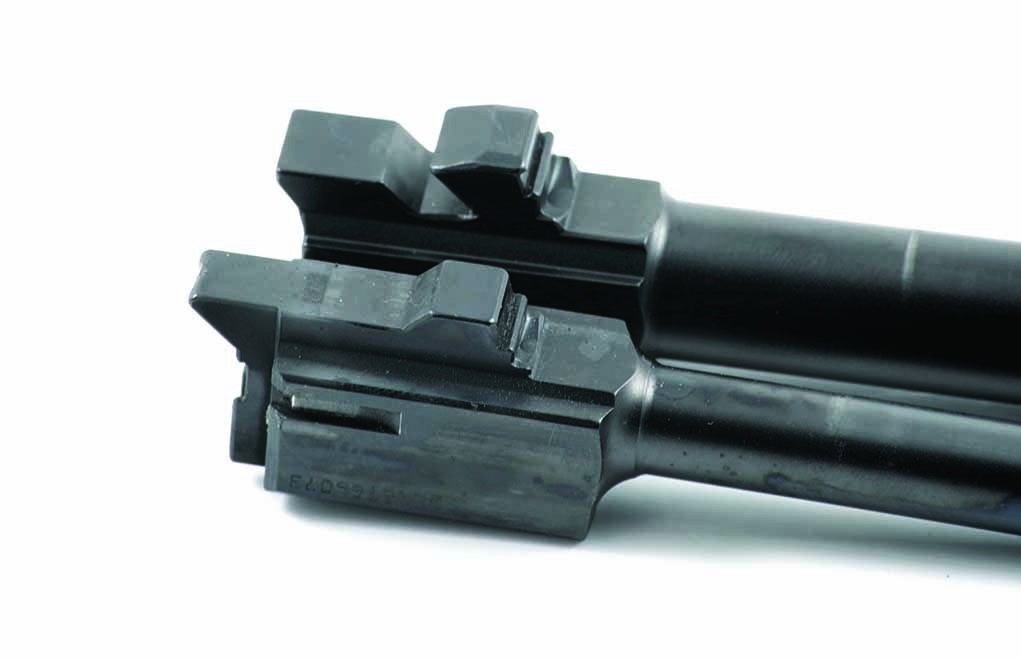

Three years in the making, the new Glock 44 finally gets the gunmaker into the .22 LR market. Was it worth the wait?
It’s not a secret that the Glock G19 is one of the most popular handguns in America. Developing a Glock chambered in .22 LR sounds like a no-brainer. It’s been three years in development, but that’s exactly what Glock did. The Glock 44, chambered in .22 Long Rifle, stays true to the Glock design, but it has a few differences to compensate for the no-recoil .22 LR cartridge.
The Glock 44 is a striker-fired, blowback, semi-automatic compact pistol. For most intents and purposes, it’s a Gen5—although Glock doesn’t call it a Gen5. It uses a modified G19 Gen5 frame and a hybrid polymer/steel slide. The barrel is the Glock Marksman Barrel (GMB) and is not a fixed-barrel like most rimfire handguns. The barrel stays straight during the entire cycling of the action.

The Glock 44 can be adjusted to various shooter preferences via an ambidextrous slide stop lever, reversible mag catch and four interchangeable back straps (two beavertail and two standard). It comes with two 10-round magazines, and the polymer rear sight is adjustable for windage and elevation.
The entire Glock 44 is about 10 ounces lighter than the G19, and the majority of that weight reduction is the slide. Most .22 handguns have an aluminum slide, but Glock wanted steel; it’s far more durable. But a steel slide would weigh too much for a .22 LR cartridge to cycle reliably. So, Glock designed a steel sub-structure and incorporated polymer—which Glock obviously knows very well.
For friction points, you always want steel on steel and polymer on polymer, because steel on polymer will expedite wear on those parts. The steel sub-structure is what makes contact with the metal slide rails on the frame, so there’s no friction or stress on the polymer portion of the slide. The slide face where the cartridge sits is also steel, as is the nose ring that the barrel goes through.
The slide internals don’t look much different than standard Glock OEM parts, but there are some changes, mostly due to the caliber. The big difference is the GMB. The chamber block is roughly the size of a G19 but has different locking lugs—because it’s not a tilt-barrel—and a ghost hole on top that’s a loaded chamber indicator.
The slide will accept any aftermarket sights designed for the G19. Nevertheless, take note if you go that route, because the dovetail is polymer, and metal sights could cause damage during installation if care is not taken.

If you remove the slide, most noticeable is the locking block, which is polymer instead of metal, as well as the area in the frame where the locking block is located. It’s designed so that a G19 and a G44 can’t swap slides.
The trigger is all Glock. The take-up is slightly spongy, but it has a clean break. Glock lists the pull weight at 5.8 pounds; mine averaged about 5.5. For Glock users who don’t care for Glock factory triggers, the G44 will accept aftermarket triggers designed for the G19 Gen5.
When the Glock 44 was announced, the Internet almost exploded—about half with excitement and about half with hate. A lot of that hate centered on the magazine; in particular, the fact that it’s 10 rounds. But why 10 rounds? Why not 15? Everyone has 10. Some new .22s have more.

The short answer: Glock wanted more rounds too, but during the nearly 14 million rounds fired during its three years of development, having more than 10 rounds in the magazine didn’t meet expectations for reliability.
Although I’d rather have more rounds, I’m fine with that answer. However, for those of us who want more than 10 rounds, ProMag has a magazine in development for the G44. There‘s no set magazine capacity yet, but it will be at least 14 rounds. Its expected ship date is by March 1, 2020.
Aside from the 10-round capacity, one of the things I like most about the Glock 44 is the magazine. It has the same outer dimensions as the G19 magazine. In fact, they’ll fit into each other’s mag well (although my G44 mag won’t lock securely into the G19 mag well).
Why is this so important? Reloads—especially for training. Most .22 pistols have long, slim magazine tubes that are barely larger than the .22 rounds they hold. If you’re practicing realistic reloads, those suck. They’re slow; it’s hard to hit the slot in the mag well under pressure; and the mag wells jam up if you don’t insert them perfectly straight. Glock did it right with the design of the G44 mags, down to the load-assist lever on both sides.
What the Glock 44 Is Not
The Glock 44 stands out from the crowd for several reasons. Foremost, while a majority of the .22 LR handguns in this category feel like replicas, the G44 is a true Glock. It’s the actual Glock design that we know, and it feels like a Glock. More importantly, it shoots like a Glock. Same Glock feel, same Glock trigger, same Glock controls, same Glock maintenance/disassembly, same Glock … well, you get it: It’s a Glock.
Range Time
I know Glock’s goal for the Glock 44 is to shoot everything reliably. But, in reality, .22 ammunition has a very large variation in performance. Glock tested the G44, firing more than 14 million rounds of more than 120 makes of ammo to make sure it could reliably shoot anything. So, reliability was also my focus. I fired 1,500 rounds using 18 different loads.

The Glock 44 I tested just did not like four of the 18 loads I used, which accounted for 350 rounds. It was obvious that it was an issue with the ammo, because almost every time I had a malfunction, it was preceded by a weak-sounding discharge, and the slide either barely cycled or had a weak cycle—often so weak that the spent case barely made it out of the ejection port. Twice, the discharge was so weak that I was convinced it was a squib load, and I disassembled the gun and checked the barrel (I did lubricate the slide before testing, and I added two drops of lubrication after about 500 rounds).
For the rest of the 1,150 rounds fired from 14 different loads, there were 18 malfunctions, seven of which were also due to cartridges with weak powder charges that didn’t completely cycle the slide. Four times, the weak charge wouldn’t cycle the slide enough to extract; seven times, it extracted, but not enough to eject; and there were seven failures to feed (the bullet nose hit outside of chamber and got stuck. These were the seven malfunctions that weren’t related to an underpowered cartridge but were most likely due to carbon buildup. Five happened after). Six times, the slide did not lock back after the last round fired, because the round didn’t have enough power to cycle the slide far enough to lock back. But I don’t count these as failures.
Wrapping it Up
The Glock 44 fills a void in Glock’s lineup that shooters have been asking to have filled for years. It’s not sexy like a carbine or a single-stack 10mm, but it’s probably the thing Glock users have been asking for the longest. The G44 is going to be extremely popular, and Glock will sell a lot of them.
Glock 44 Specs:
CALIBER: .22 Long Rifle
ACTION TYPE: Semi-auto
FRAME: Polymer
CAPACITY: 10-round magazine
SLIDE: Steel/polymer fusion
BARREL: Glock Marksman Barrel; 4.02 in.; hex
TRIGGER: 5.8 lb. (5.5 lb., as tested)
SIGHTS: Polymer; adjustable
WEIGHT: 14.74 oz. (with empty mag)
OVERALL LENGTH: 7.28 in.
HEIGHT (WITH MAG): 5.04 in.
OVERALL WIDTH: 1.26 in.
SLIDE WIDTH: 1.01 in. (measured at steel sub-structure)
ACCESSORIES: Includes two 10-round mags; threaded barrel available MSRP: $430 (street price estimate: $370; blue label: $350)
For more information on the Glock 44, please visit us.glock.com/en.
More Glock Reviews:
- Glock 17 Review
- Glock 19 Review
- Glock 20 Review
- Glock 22 Review
- Glock 26 Review
- Glock 29 Review
- Glock 30 Review
- Glock 34 Review
- Glock 40 Review
- Glock 41 Review
- Glock 42 Review
- Glock 43 Review
- Glock 44 Review
- Glock 43X Review

Next Step: Get your FREE Printable Target Pack
Enhance your shooting precision with our 62 MOA Targets, perfect for rifles and handguns. Crafted in collaboration with Storm Tactical for accuracy and versatility.
Subscribe to the Gun Digest email newsletter and get your downloadable target pack sent straight to your inbox. Stay updated with the latest firearms info in the industry.

![Best Concealed Carry Guns In 2025 [Field Tested] Wilson Combat EDC X9S 1](https://gundigest.com/wp-content/uploads/Wilson-Combat-EDC-X9S-1-324x160.jpg)


![Best 9mm Carbine: Affordable PCCs [Tested] Ruger Carbine Shooting](https://gundigest.com/wp-content/uploads/Ruger-Carbine-Shooting-100x70.jpg)
![Best AR-15: Top Options Available Today [Field Tested] Harrington and Richardson PSA XM177E2 feature](https://gundigest.com/wp-content/uploads/Harrington-and-Richardson-PSA-XM177E2-feature-100x70.jpg)

My 44 is not very reliable with several types of ammo. It works well with CCI Blazer which is surprising considering Blazer is a “bulk” type load. It definitely prefers 40 grain high speed loads. I had quite a few issues with 36 gr. and 38 gr. loads from Federal and CCI. CCI Mini Mag 40 gr. worked well. The 44 shoots like a Glock, which means it is no tack driver. I’d recommend a Ruger Mark IV to get better function and accuracy
My .22 pistol is a RUGER Single Six that has both .22 LR and .22 WMR cylinders.I keep the WMR cylinder in it for “real” firepower.
Howsomever, I’ve ordered a RUGER 57 (5.7 x 28) for a “slightly upgraded .22” pistol. I may see it in 6 months!
Literally no one asked.